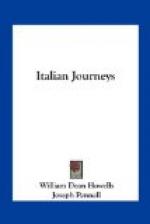V.
The Ghetto was in itself indifferent to us; it was merely our way to the Library, whither the great memory of Ariosto invited us to see his famous relics treasured there.
We found that the dead literati of Ferrara had the place wholly to themselves; not a living soul disputed the solitude of the halls with the custodians, and the bust of Ariosto looked down from his monument upon rows of empty tables, idle chairs, and dusty inkstands.
The poet, who was painted by Titian, has a tomb of abandoned ugliness, and sleeps under three epitaphs; while cherubs frescoed on the wall behind affect to disclose the mausoleum, by lifting a frescoed curtain, but deceive no one who cares to consider how impossible it would be for them to perform this service, and caper so ignobly as they do at the same time. In fact this tomb of Ariosto shocks with its hideousness and levity. It stood formerly in the Church of San Benedetto, where it was erected shortly after the poet’s death, and it was brought to the Library by the French, when they turned the church into a barracks for their troops. The poet’s dust, therefore, rests here, where the worm, working silently through the vellum volumes on the shelves, feeds upon the immortality of many other poets. In the adjoining hall are the famed and precious manuscripts of Ariosto and of Tasso. A special application must be made to the librarian, in order to see the fragment of the Furioso in Ariosto’s hand, and the manuscript copy of the Gerusalemma, with the corrections by Tasso. There are some pages of Ariosto’s Satires, framed and glazed for the satisfaction of the less curious; as well as a letter of Tasso’s, written from the Hospital of St. Anna, which the poet sends to a friend, with twelve shirts, and in which he begs that his friend will have the shirts mended, and cautions him “not to let them be mixed with others.” But when the slow custodian had at last unlocked that more costly fragment of the Furioso, and placed it in my hands, the other manuscripts had no value for me. It seems to me that the one privilege which travel has reserved to itself, is that of making each traveller, in presence of its treasures, forget whatever other travellers have said or written about them. I had read so much of Ariosto’s industry, and of the proof of it in this manuscript, that I doubted if I should at last marvel at it. But the wonder remains with the relic, and I paid it my homage devoutly and humbly, and was disconcerted afterward to read again in my Valery how sensibly all others had felt the preciousness of that famous page, which, filled with half a score of previous failures, contains in a little open space near the margin, the poet’s final triumph in a clearly written stanza. Scarcely less touching and interesting than Ariosto’s painful work on these yellow leaves, is the grand and simple tribute which another Italian poet was allowed to inscribe on one of them: “Vittorio Alfieri beheld and venerated;” and I think, counting over the many memorable things I saw on the road to Rome and the way home again, this manuscript was the noblest thing and best worthy to be remembered.




